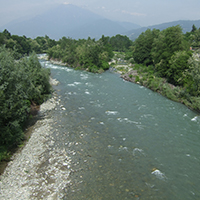Supraseasonal drought in an Alpine river: effects on benthic primary production and diatom community
Diatoms and chlorophyll a in an intermittent Alpine river

Submitted: 30 July 2019
Accepted: 12 December 2019
Published: 15 January 2020
Accepted: 12 December 2019
Abstract Views: 1366
PDF: 495
Supplementary: 144
HTML: 40
Supplementary: 144
HTML: 40
Publisher's note
All claims expressed in this article are solely those of the authors and do not necessarily represent those of their affiliated organizations, or those of the publisher, the editors and the reviewers. Any product that may be evaluated in this article or claim that may be made by its manufacturer is not guaranteed or endorsed by the publisher.
All claims expressed in this article are solely those of the authors and do not necessarily represent those of their affiliated organizations, or those of the publisher, the editors and the reviewers. Any product that may be evaluated in this article or claim that may be made by its manufacturer is not guaranteed or endorsed by the publisher.
Similar Articles
- Guojia Huang, Qiuhua Li, Xiaoqing Wang, Mengshu Han, Lei Li, Jing Xiao, Yipeng Liu, Responses of phytoplankton functional groups to environmental factors in the Maixi River, southwest China , Journal of Limnology: Vol. 77 No. 1 (2018)
- Joanna Martinet, Stéphane Descloux, Pierre Guédant, Frederic Rimet, Phytoplankton functional groups for ecological assessment in young sub-tropical reservoirs: case study of the Nam-Theun 2 Reservoir, Laos, South-East Asia , Journal of Limnology: Vol. 73 No. 3 (2014)
- María I. Ríos-Pulgarín, Mario Barletta, María C. Arango-Jaramillo, Néstor J. Mancera-Rodríguez, The role of the hydrological cycle on the temporal patterns of macroinvertebrate assemblages in an Andean foothill stream in Colombia , Journal of Limnology: Vol. 75 No. s1 (2016): Proceedings of the 6th National Congress of Limnology
- Hortência de Souza Barroso, Janaina A. Santos, Rozane V. Marins, Luiz Drude Lacerda, Assessing temporal and spatial variability of phytoplankton composition in a large reservoir in the Brazilian northeastern region under intense drought conditions , Journal of Limnology: Vol. 77 No. 1 (2018)
- Xing Wang, Binghui Zheng, Lusan Liu, Lijing Wang, Development and evaluation of the Lake Multi-biotic Integrity Index for Dongting Lake, China , Journal of Limnology: Vol. 74 No. 3 (2015)
- Rafał Chmara, Józef Szmeja, Krzysztof Banaś, The relationships between structural and functional diversity within and among macrophyte communities in lakes , Journal of Limnology: Vol. 77 No. 1 (2018)
- Ning Chen, Ling Liu, Yanfeng Li, Danying Qiao, Yuanpo Li, Ying Zhang, Yiyan Lv, Morphology-based classification of functional groups for potamoplankton , Journal of Limnology: Vol. 74 No. 3 (2015)
- Giuseppe Morabito, Phytoplankton assemblages in Lake Orta: has functional structure recovered in one of the largest acidic lakes in the world? , Journal of Limnology: Vol. 75 No. s2 (2016): Lake Orta: a new lease on life
- Nadezhda D. Gillett, Mark R. Luttenton, Alan D. Steinman, Spatial and temporal dynamics of phytoplankton communities in a Great Lakes drowned river-mouth lake (Mona Lake, USA) , Journal of Limnology: Vol. 74 No. 3 (2015)
- María I. Ríos-Pulgarín, Isabel C. Gil-Guarín, Mario Barletta, Néstor J. Mancera-Rodríguez, Effects of the hydrological cycle on the phycoperiphyton assemblage in an Andean foothill stream in Colombia , Journal of Limnology: Vol. 75 No. s1 (2016): Proceedings of the 6th National Congress of Limnology
You may also start an advanced similarity search for this article.

 https://doi.org/10.4081/jlimnol.2020.1933
https://doi.org/10.4081/jlimnol.2020.1933





